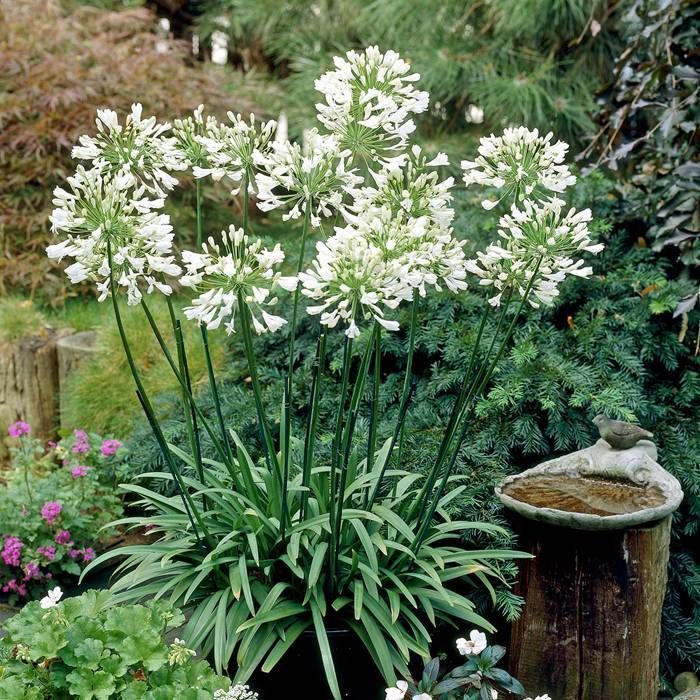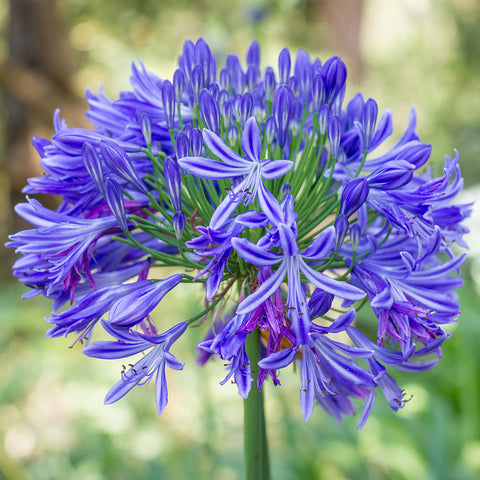Exactly how to Plant and Maintain Agapanthus in Your Garden
Exactly how to Plant and Maintain Agapanthus in Your Garden
Blog Article
Grasping the Art of Agapanthus Care: Essential Steps for Healthy And Balanced Growth and Vibrant Blossoms
In the realm of cultivation, the cultivation of agapanthus stands as a satisfying undertaking for those who look for to support these classy flowering plants. From choosing the ideal variety to mastering pruning strategies, the journey in the direction of growing thriving agapanthus plants is multifaceted and holds the crucial to unlocking the complete capacity of these botanical treasures.

Selecting the Right Agapanthus Selection

When choosing the appropriate Agapanthus variety for your yard, take into consideration factors such as environment viability, flower color, and development routine. Agapanthus, generally known as Lily of the Nile or African lily, comes in a selection of colors varying from shades of blue and purple to white. Select a flower shade that enhances your existing yard combination to create an unified landscape. Additionally, take into consideration the environment in your area to guarantee the Agapanthus range you pick can prosper in your certain conditions. Some ranges are extra tolerant of chilly temperatures, while others like warmer environments. Recognizing the growth behavior of various Agapanthus varieties is crucial for proper placement within your yard. Some selections have a clumping growth practice, suitable for containers or boundaries, while others have an even more spreading nature, appropriate for ground cover or mass plantings. By very carefully reviewing these aspects, you can choose the perfect Agapanthus selection to boost the appeal of your yard.
Perfect Planting Conditions
Thinking about the optimal ecological requirements is crucial for successful Agapanthus farming. Agapanthus flourishes in well-draining dirt with a slightly acidic to neutral pH degree. When growing, choose a place that receives full sunshine to partial shade. In hotter environments, supplying some mid-day shade can stop scorching of the leaves. Agapanthus plants are delicate to chilly temperature levels and should be secured from frost throughout winter season.
To guarantee healthy and balanced development and vibrant blooms, plant Agapanthus bulbs at a deepness of about 2-4 inches and area them 8-12 inches apart. Including raw material, such as compost, to the soil can enhance drain and fertility, advertising durable origin growth. Mulching around the base of the plants aids retain moisture and suppresses weed growth. Routine watering is important, specifically throughout the expanding period, to maintain the dirt continually wet yet not saturated.
Watering and Fertilizing Tips
Preserving appropriate moisture levels and providing important nutrients are essential elements in the care regimen for Agapanthus plants. When it comes to watering Agapanthus, it is crucial to strike a balance. These plants favor constantly moist soil but are susceptible to root rot if overwatered. Throughout the expanding period, water deeply when a week, guaranteeing the soil is well-draining to avoid waterlogging. In hotter environments or during periods of dry spell, even more constant watering may be necessary to maintain the dirt uniformly wet. Nevertheless, minimize watering in the winter season to stop water logged problems.
Fertilizing Agapanthus is essential for advertising healthy development and prolific flowers. Apply a well balanced visit here fertilizer, such as a 10-10-10 formula, in the very early spring as brand-new growth emerges. Repeat this application every 6-8 weeks throughout the growing period. Prevent extreme fertilizing, as it can cause lush vegetation at the expense of flowers. Constantly comply with the supplier's directions for correct dilution and application methods. By complying with these watering and feeding ideas, you can ensure your Agapanthus plants flourish and generate dynamic, resilient blooms.
Trimming Strategies for Agapanthus
Trimming Agapanthus plants at the appropriate times and with proper methods is critical for maintaining their health and wellness and advertising ideal development and flowering. The suitable time to trim Agapanthus remains in late winter or early spring before new development arises. Start by removing any dead or yellowing leaves near the base of the plant. Cut them as close to the ground as possible without damaging the emerging shoots.
For flowered stems, wait till the blossoms have actually perished and afterwards cut them back to the base. This not just cleans the plant's appearance however likewise motivates the growth of new flower buds. Deadheading invested blossoms can additionally reroute the plant's energy into producing more blossoms instead of i loved this establishing seeds. Nevertheless, if you intend to collect seeds for propagation, leave some blossoms to completely dry and fully grown on the plant.
Remember to utilize tidy, sharp devices to make accurate cuts and reduce the danger of introducing diseases. Agapanthus. Normal pruning will aid keep your Agapanthus looking healthy and balanced and neat while guaranteeing a bountiful display screen of lovely flowers
Handling Usual Bugs and Conditions
After making certain appropriate trimming techniques for Agapanthus, it is crucial to deal you can look here with common bugs and diseases that can affect the health and wellness and vitality of these plants. One common bug that impacts Agapanthus is the Agapanthus gall midget.
Another typical concern is fungal fallen leave place, which presents as dark lesions on the fallen leaves. To stop fungal illness, ensure great air blood circulation around the plants, avoid overhead watering, and eliminate any kind of infected leaves immediately. In addition, Agapanthus plants can suffer from root rot if they are grown in improperly draining pipes soil. To prevent this, plant Agapanthus in well-draining soil and prevent overwatering. By being cautious and taking prompt action against bugs and conditions, you can help your Agapanthus plants grow and produce vivid blooms.

Final Thought
Finally, understanding the art of agapanthus treatment entails picking the best selection, providing excellent planting conditions, appropriate watering and feeding, proper pruning methods, and addressing typical insects and diseases. By following these essential actions, you can ensure healthy development and vivid blooms for your agapanthus plants. Bear in mind to on a regular basis check and maintain your plants to advertise their total well-being and long life.
To ensure healthy and balanced development and vivid blooms, plant Agapanthus bulbs at a deepness of concerning 2-4 inches and area them 8-12 inches apart. By following these watering and feeding tips, you can guarantee your Agapanthus plants thrive and create vivid, long-lasting flowers.
One typical parasite that influences Agapanthus is the Agapanthus gall midge. In addition, Agapanthus plants can experience from root rot if they are planted in inadequately draining soil. By complying with these essential actions, you can make certain healthy growth and dynamic flowers for your agapanthus plants.
Report this page